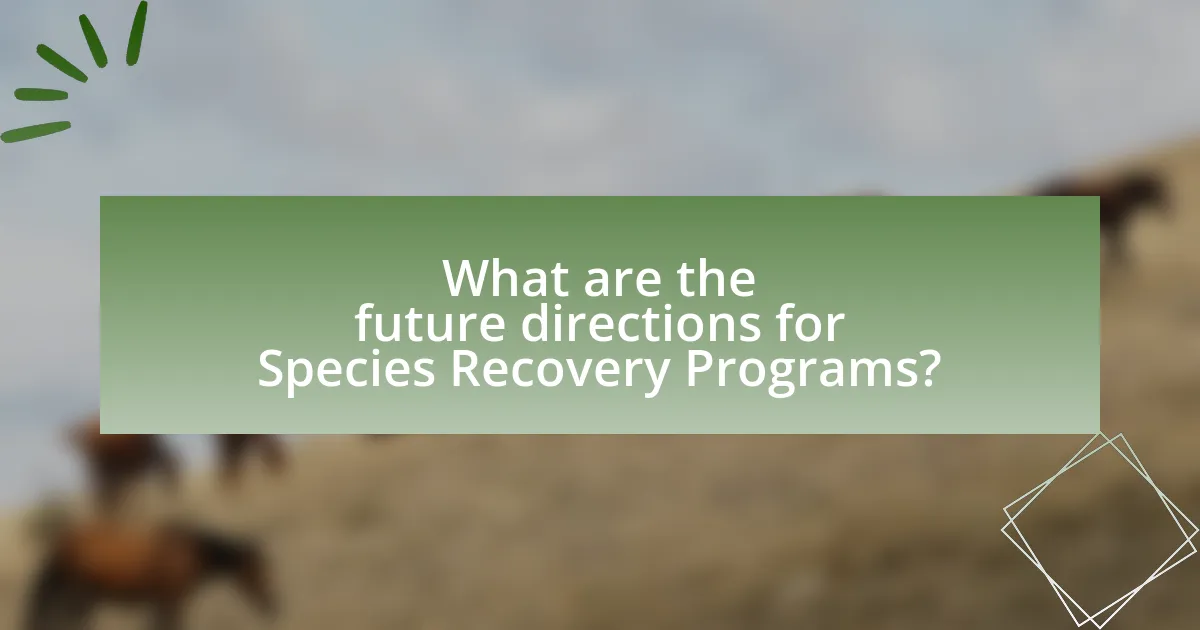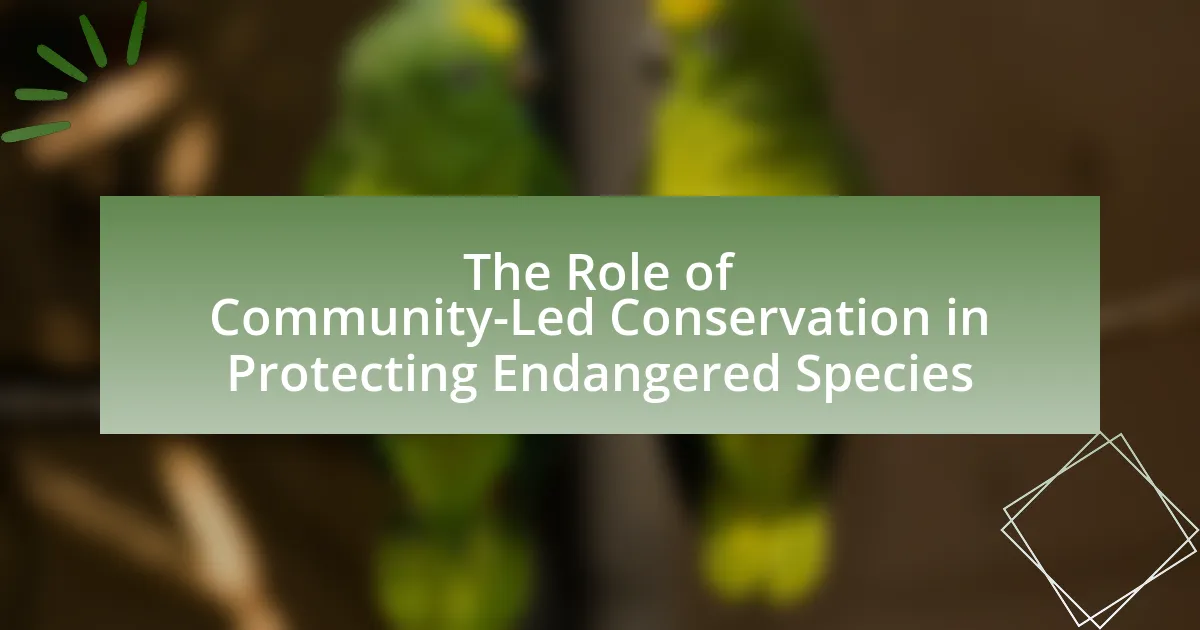Species Recovery Programs are structured initiatives designed to restore populations of endangered or threatened species to sustainable levels through various strategies such as habitat restoration, legal protection, captive breeding, and public education. This article examines notable case studies of successful recovery efforts, including the American bald eagle, California condor, and gray wolf, highlighting the key components and strategies that contributed to their recovery. It also discusses the ecological benefits of these programs, the challenges faced, and the importance of community involvement and stakeholder collaboration in achieving successful outcomes. Additionally, the article explores future directions for recovery programs, emphasizing the role of technology and data analytics in enhancing conservation efforts.

What are Species Recovery Programs?
Species Recovery Programs are structured initiatives aimed at restoring populations of endangered or threatened species to sustainable levels. These programs often involve habitat restoration, legal protection, captive breeding, and public education to mitigate threats such as habitat loss, poaching, and climate change. For example, the U.S. Endangered Species Act has facilitated the recovery of species like the American bald eagle, which was removed from the endangered species list in 2007 due to successful conservation efforts.
How do Species Recovery Programs function?
Species Recovery Programs function by implementing targeted conservation strategies aimed at restoring populations of endangered species. These programs typically involve habitat restoration, legal protection, captive breeding, and public education initiatives. For example, the U.S. Fish and Wildlife Service’s recovery efforts for the California condor included breeding programs that successfully increased the population from 27 individuals in 1987 to over 500 in 2021. This demonstrates the effectiveness of structured recovery plans that combine scientific research with community involvement and policy support.
What are the key components of a successful Species Recovery Program?
A successful Species Recovery Program includes habitat restoration, population monitoring, stakeholder engagement, and legal protection. Habitat restoration ensures that the environment can support the species, as seen in the recovery of the California condor, where habitat management was crucial for their survival. Population monitoring allows for tracking the species’ numbers and health, which was effectively implemented in the recovery of the gray wolf in Yellowstone National Park, leading to informed management decisions. Stakeholder engagement involves collaboration with local communities and organizations, exemplified by the partnership in the recovery of the Florida panther, which included landowners and conservation groups. Legal protection, such as the Endangered Species Act in the United States, provides a framework for safeguarding species and their habitats, contributing to the successful recovery of various endangered species.
How do these components interact to promote recovery?
Components such as habitat restoration, species protection, and community engagement interact synergistically to promote recovery in species. Habitat restoration provides the necessary environment for species to thrive, while species protection ensures that populations are safeguarded from threats like poaching and habitat loss. Community engagement fosters local support and involvement, which is crucial for the sustainability of recovery efforts. For instance, the recovery of the California condor involved habitat protection, captive breeding, and public education, leading to a significant increase in population numbers from 27 individuals in 1987 to over 500 today. This demonstrates how the interplay of these components can effectively enhance recovery outcomes.
Why are Species Recovery Programs important?
Species Recovery Programs are important because they aim to restore endangered species populations and their habitats, thereby promoting biodiversity and ecosystem health. These programs implement targeted conservation strategies, such as habitat restoration, breeding programs, and legal protections, which have proven effective in reversing population declines. For instance, the recovery of the American bald eagle, which was removed from the endangered species list in 2007 due to successful conservation efforts, exemplifies the positive impact of such programs. This case highlights that structured recovery initiatives can lead to significant increases in species numbers and stability, ultimately benefiting ecological balance and human interests.
What ecological benefits do Species Recovery Programs provide?
Species Recovery Programs provide significant ecological benefits by restoring biodiversity and stabilizing ecosystems. These programs help to increase the population of endangered species, which in turn supports the overall health of ecosystems by maintaining food webs and ecological balance. For example, the recovery of the gray wolf in Yellowstone National Park has led to the regulation of elk populations, allowing vegetation to recover and benefiting other species such as beavers and birds. Additionally, successful recovery efforts can enhance genetic diversity, making species more resilient to environmental changes and diseases.
How do Species Recovery Programs contribute to biodiversity conservation?
Species Recovery Programs contribute to biodiversity conservation by actively restoring endangered species populations and their habitats. These programs implement targeted actions such as habitat restoration, captive breeding, and reintroduction of species into their natural environments. For example, the California condor recovery efforts have successfully increased the population from 27 individuals in 1987 to over 500 today, demonstrating the effectiveness of such initiatives in reversing species decline. By focusing on specific species, these programs help maintain ecosystem balance and promote genetic diversity, which is crucial for resilience against environmental changes.

What are some notable case studies of successful Species Recovery Programs?
Notable case studies of successful Species Recovery Programs include the recovery of the American Bald Eagle, the California Condor, and the Gray Wolf. The American Bald Eagle was removed from the endangered species list in 2007 after populations increased from fewer than 500 breeding pairs in the 1960s to over 10,000 pairs due to habitat protection and banning of DDT. The California Condor, once reduced to 27 individuals in 1987, has seen its population rise to over 500 through captive breeding and reintroduction efforts. The Gray Wolf, particularly in Yellowstone National Park, was reintroduced in 1995, leading to a stable population of over 1,700 wolves in the Northern Rockies by 2020, demonstrating the effectiveness of targeted conservation strategies.
How did the California Condor recovery program achieve success?
The California Condor recovery program achieved success through a combination of captive breeding, habitat protection, and public education initiatives. Captive breeding began in 1987 when the population dwindled to just 27 individuals, leading to the establishment of breeding programs that successfully increased the population to over 500 condors by 2023. Habitat protection efforts included the designation of critical habitats and the reduction of lead poisoning risks by banning lead ammunition in key areas. Additionally, public education campaigns raised awareness about the species and its conservation needs, fostering community support for recovery efforts. These strategies collectively contributed to the stabilization and growth of the California Condor population.
What strategies were implemented in the California Condor recovery?
The California Condor recovery involved several key strategies, including captive breeding, habitat protection, and public education. Captive breeding programs initiated in the 1980s successfully increased the population from 27 individuals to over 500 by 2023. Habitat protection efforts focused on preserving critical areas in California, Arizona, and Utah, ensuring the birds had safe environments to thrive. Additionally, public education campaigns raised awareness about the species and its conservation needs, fostering community support for recovery efforts. These combined strategies have been essential in reversing the decline of the California Condor.
What challenges were faced during the California Condor recovery?
The California Condor recovery faced several significant challenges, including habitat loss, lead poisoning, and low genetic diversity. Habitat loss resulted from urban development and agricultural expansion, which reduced the available space for the condors to thrive. Lead poisoning, primarily from ingesting spent lead ammunition, was a critical threat that led to high mortality rates among the population. Additionally, low genetic diversity due to a historical population bottleneck made the species more vulnerable to disease and reduced reproductive success. These challenges necessitated intensive management efforts, including captive breeding programs and habitat protection initiatives, to ensure the survival of the California Condor.
What lessons can be learned from the recovery of the American Bald Eagle?
The recovery of the American Bald Eagle teaches critical lessons about conservation success through targeted intervention and public engagement. First, the implementation of the Endangered Species Act in 1973, which provided legal protection, was essential in reversing the decline of the species. By 2007, the Bald Eagle was removed from the endangered species list, demonstrating the effectiveness of legal frameworks in conservation efforts.
Second, the reduction of harmful pesticides, particularly DDT, which was banned in the United States in 1972, played a significant role in the recovery of the Bald Eagle population. Studies indicated that DDT caused eggshell thinning, leading to reproductive failures. The ban allowed for population stabilization and growth, highlighting the importance of addressing environmental threats.
Lastly, public awareness and education campaigns significantly contributed to the Bald Eagle’s recovery. Organizations and government agencies engaged communities in conservation efforts, fostering a sense of stewardship. This collective action resulted in increased support for conservation policies and habitat protection, illustrating the power of community involvement in successful recovery programs.
What role did legislation play in the Bald Eagle’s recovery?
Legislation played a crucial role in the Bald Eagle’s recovery by implementing protective measures that significantly reduced threats to the species. The Bald and Golden Eagle Protection Act of 1940 and the Endangered Species Act of 1973 established legal frameworks that prohibited the killing, capturing, or disturbing of Bald Eagles and their nests. These laws facilitated habitat protection and conservation efforts, leading to a dramatic increase in Bald Eagle populations from fewer than 500 nesting pairs in the lower 48 states in the 1960s to over 10,000 pairs by 2007. The legal protections, combined with habitat restoration and public awareness campaigns, were instrumental in the successful recovery of the Bald Eagle, ultimately leading to its removal from the endangered species list in 2007.
How did public awareness campaigns impact the Bald Eagle’s recovery?
Public awareness campaigns significantly contributed to the Bald Eagle’s recovery by educating the public about the species’ endangered status and the importance of conservation efforts. These campaigns, particularly during the 1970s and 1980s, highlighted the threats posed by habitat destruction and pesticide use, notably DDT, which led to population declines. As a result, increased public support for protective legislation, such as the Endangered Species Act, emerged, facilitating habitat restoration and legal protections. By 2007, these efforts culminated in the Bald Eagle being removed from the endangered species list, demonstrating the effectiveness of public engagement in conservation initiatives.

What are the future directions for Species Recovery Programs?
Future directions for Species Recovery Programs include enhancing habitat restoration, increasing genetic diversity, and implementing adaptive management strategies. Habitat restoration focuses on rehabilitating ecosystems to support species populations, as seen in the recovery of the California condor, where habitat improvements have led to population growth. Increasing genetic diversity is crucial for resilience against diseases and environmental changes; for instance, the Florida panther recovery efforts included genetic management to prevent inbreeding. Adaptive management strategies allow for ongoing adjustments based on monitoring data, exemplified by the success of the red-cockaded woodpecker recovery, which utilized data-driven approaches to refine conservation tactics. These directions aim to create sustainable populations and ecosystems, ensuring long-term species survival.
How can technology enhance Species Recovery Programs?
Technology can enhance Species Recovery Programs by providing advanced tools for monitoring, data collection, and habitat restoration. For instance, satellite imagery and drones enable precise tracking of wildlife populations and their habitats, allowing for timely interventions. Additionally, genetic analysis technologies, such as CRISPR, can assist in increasing genetic diversity among endangered species, which is crucial for their survival. A study published in the journal “Conservation Biology” highlights that the use of GPS collars has improved the understanding of animal movements, leading to more effective management strategies. These technological advancements not only streamline conservation efforts but also increase the likelihood of successful species recovery.
What innovative tools are being used in modern recovery efforts?
Innovative tools used in modern recovery efforts include genetic rescue techniques, drone technology, and environmental DNA (eDNA) analysis. Genetic rescue techniques enhance genetic diversity in endangered populations, which has been shown to improve their resilience and reproductive success, as evidenced by the recovery of the Florida panther. Drone technology facilitates habitat monitoring and species tracking, allowing for efficient data collection over large areas, demonstrated in the monitoring of seabird populations in remote islands. Environmental DNA analysis enables the detection of species presence through water or soil samples, providing a non-invasive method to assess biodiversity, as utilized in the monitoring of aquatic ecosystems.
How can data analytics improve decision-making in recovery programs?
Data analytics can significantly enhance decision-making in recovery programs by providing actionable insights derived from large datasets. By analyzing trends, patterns, and outcomes from previous recovery efforts, stakeholders can identify the most effective strategies and allocate resources more efficiently. For instance, a study on the recovery of the California condor demonstrated that data analytics helped track population dynamics and habitat use, leading to targeted conservation actions that increased survival rates. This evidence illustrates that leveraging data analytics not only informs better decision-making but also optimizes the overall effectiveness of recovery initiatives.
What best practices should be adopted for future Species Recovery Programs?
Future Species Recovery Programs should adopt a multi-faceted approach that includes habitat restoration, genetic diversity management, stakeholder engagement, and ongoing monitoring. Habitat restoration is crucial as it addresses the primary threats to species survival, evidenced by the success of the California condor recovery, where habitat protection led to population increases. Genetic diversity management ensures that populations remain resilient to diseases and environmental changes, as seen in the Florida panther recovery efforts, which included genetic interventions to enhance diversity. Stakeholder engagement fosters community support and collaboration, which was vital in the recovery of the gray wolf in Yellowstone National Park, where local involvement was key to successful reintroduction. Ongoing monitoring allows for adaptive management, ensuring that strategies can be adjusted based on real-time data, a practice that has proven effective in the recovery of the American alligator, where continuous assessment informed conservation actions.
How can collaboration among stakeholders improve recovery outcomes?
Collaboration among stakeholders can significantly improve recovery outcomes by fostering shared resources, expertise, and coordinated efforts. When various stakeholders, such as government agencies, non-profit organizations, local communities, and researchers, work together, they can create comprehensive recovery strategies that address multiple facets of species conservation. For instance, the recovery of the California condor involved collaboration among federal and state agencies, conservation groups, and local communities, leading to increased funding, habitat restoration, and successful breeding programs. This collaborative approach resulted in the population of California condors increasing from 27 individuals in 1987 to over 500 today, demonstrating that stakeholder collaboration can lead to tangible and successful recovery outcomes.
What role does community involvement play in successful recovery initiatives?
Community involvement is crucial for the success of recovery initiatives as it fosters local stewardship and enhances the effectiveness of conservation efforts. Engaging communities in recovery programs leads to increased awareness, support, and participation, which are essential for the long-term sustainability of species recovery. For instance, the recovery of the California condor involved local communities in habitat restoration and monitoring efforts, resulting in a significant increase in the population from 27 individuals in 1987 to over 500 today. This demonstrates that when communities are actively involved, recovery initiatives are more likely to succeed due to shared responsibility and local knowledge.




